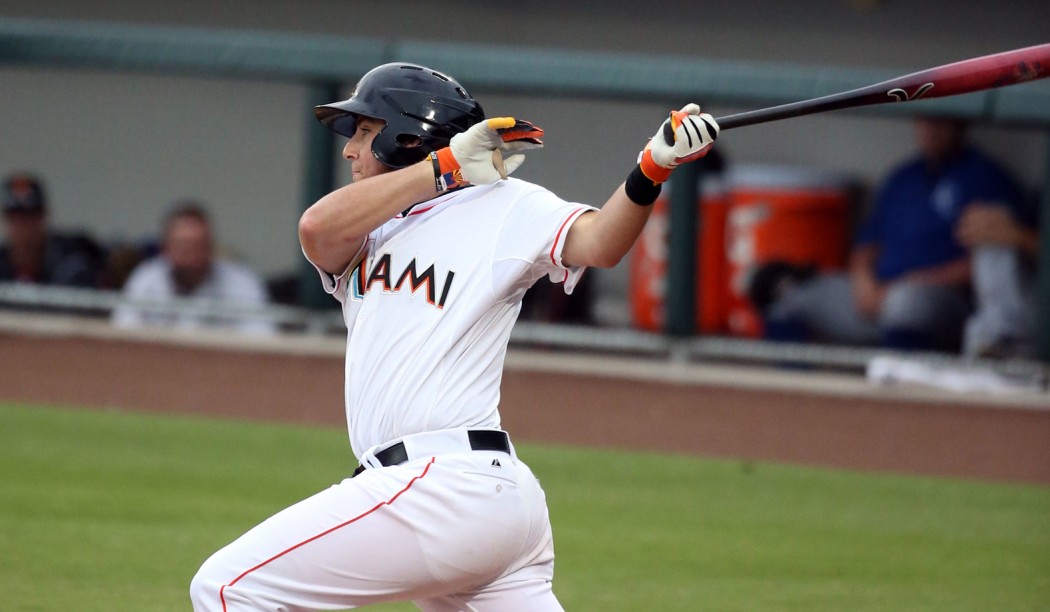Feature Photo: Austin Dean, OF, Marlins
We call them utility men or, if they’re pitchers, swingmen. They’re the ‘tweeners who don’t quite fit perfectly at any one position. They’re the grinders and the spark plugs; the jacks-of-all-trades and yet masters of none, and, if they’re starting, they’re always at the spot their teams seemingly want to upgrade. They don’t come to the major leagues with a prospect pedigree that affords them multiple chances to fail. They don’t have the ceiling you dream about. Nothing is given to them. They have to prove themselves at every level of the minor leagues. Constantly.
Yet, there is great value in role players on today’s game. Teams need to round out their rosters, fill in the gaps they may be missing from their starters, and work within the new-era dynamics of salary cap management, where just 2-3 contracts can engorge a payroll, leaving teams in a position to find good talent on the cheap.
Role players provide defense, versatility (on the mound or in the field), a solid bat off the bench, or useful arm out of the bullpen. Ideally they should bee good enough to fill in short term if a starter hits the disabled list. Fill the role, make no mistakes, and move on to the next opportunity, whenever called upon.
Teams like the Cardinals and the Giants have shown that the ability to fill this type of player from within during the season, and can keep their team afloat without having to expend their prospect currency in the trade market. Tommy Pham comes to mind as a great 2015 example with the Cardinals, where he filled multiple roles successfully while Jon Jay, Matt Holliday, and later Randall Grichuk, took turns on the disabled list. The Cardinals were able to avoid a (potentially costly) mid-season trade thanks to Pham’s versatility.
Role players also provide their teams with inexpensive cost-controlled options, which helps keep the payroll flexible. That flexibility benefits both the small market teams trying to keep costs down, and the big market teams trying to stay under the competitive balance tax, commonly known as the luxury tax, explained well by Maury Brown recently over at Forbes.
Some of these players have the ability to fill in at multiple positions, and that adds value in terms of roster flexibility, in many cases allowing teams to carry an extra arm in the bullpen. Other players are borderline or second-division starters, making them valuable as part of a trade package for contending teams. They can help sweeten the pot when teams are trying to acquire a needed win-now player. On the flip side of the coin, they can fill in short term as starters for the team that trades them. Having one of these players ready to step in may allow a rebuilding team to trade a veteran for long-term help and perhaps simultaneously serve as a low-cost bridge until a more highly regarded prospect is ready.
If you had the chance to attend some 2015 Arizona Fall League games, then you saw quite a few of these players. Where in some years it has been prospect-laden, this year’s AFL seemed to be the season of the ‘Role 4’ player. Here are a few of my favorite role players that I saw in action, and what the 2016 might bring for each:
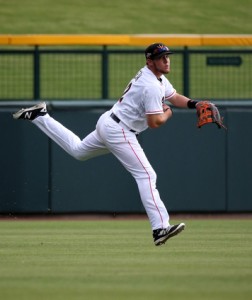
Austin Dean, OF, Marlins
Austin Dean, OF, Marlins
Ht/Wt: 6’1″/190 | B/T: R/R | Age (as of 1/1/16): 22y, 3m
Acquisition Period: 4th Rd., 2012 MLB First-Year Player Draft (MIA)
2015 Stats (High A): 578 PA | .268/.318/.366 | 5 HR | 52 RBI
What he brings: Dean surprised me with his quick hands and his good hand-eye coordination. He can turn on good fastballs and is able to make adjustments from pitch-to-pitch. Those who saw the AFL All-Star Game got to see a little bit of what Dean brings in just one plate appearance. When hard-throwing Braves prospect Lucas Sims started him with two breaking balls, and then tried to blow a 96 mph heater by him, Dean was ready – he quickly got his hands in and drove the ball down the right field line for what turned out to be an inside-the-park home-run. He’s not a burner, but he is at least an average runner, and one person I talked to had him at a very respectable 4.1 time to first base. What Dean can bring to the Marlins is an above-average bat, and a player who can play all three outfield positions along with solid baserunning skills.
Why he’s a likely role player: Dean fits best in a corner outfield spot but doesn’t have the present power teams tend to favor at those positions. He can play center field, but his fringy arm and average speed make him a stretch as an everyday player there.
How he fits: Right now Dean fits best as a fourth outfielder with the Marlins. He’ll start the season in Double-A Jacksonville but his polished bat could see him moving up to Triple-A New Orleans midseason, and knocking at the door of a big league opportunity soon thereafter. Though he is projected to be their best outfield prospect at the upper levels of the Marlins system, the Marlins should be in no hurry to bring him up as they have one of the best young outfields in baseball already in place. However, there has been some talk about them moving Marcell Ozuna in a trade. That could open up an opportunity if Dean can handle center field. It will be tougher for him to find a corner spot — especially with his fringy arm, which relegates him to left if he is to play full time. The presence of Christian Yelich in left for the foreseeable future makes that an unlikely landing spot for him as a starter with the Marlins.
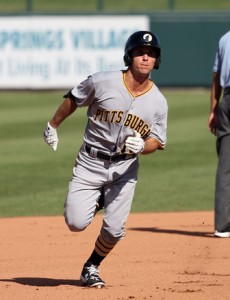
Adam Frazier, SS/OF, Pirates
Adam Frazier, SS-OF, Pirates
Ht/Wt: 5’11″/170 | B/T: L/R | Age (as of 1/1/2016): 24y, 1m
Acquisition Period: 6th Rd., 2013 MLB First-Year Player Draft (PIT)
2015 Stats (Double-A): 423 PA | .324/.384/.416 | 2 HR | 30 RBI
What he brings: Simple – versatility. Frazier is the most versatile player on my list. He is able to play all three outfield spots, shortstop, and though I didn’t see it this fall, he has also played second and third base in his minor league career. At the plate, he brings a solid gap-to-gap approach with a short, quick swing that helps him make frequent contact. On defense, he is more the jack-of-all-trades type in that he can hold his own at multiple positions, but isn’t going to dazzle at any one spot. On the bases he’s a slightly above-average runner with good instincts. He’s the type of player that you can plug in short term and he’ll hold down the fort just fine, because he won’t hurt you in any one aspect of the game, except for HR power.
Why he’s a likely role player: Frazier doesn’t have a particularly strong arm, and the same could be said for his quickness, so while he can fill in at the positions that are best suited to carry his bat, short and center, they are a stretch on defense if he has to be utilized full time. His lack of power makes him a poor fit at any of the corner outfield spots. If there is a position he may fit best as an everyday player, it’s at second base.
How he fits: The Pirates have a talented young outfield so there are no openings there, but they just dealt Neil Walker December 9th, and have no obvious replacement for him other than Jordy Mercer, Pedro Florimon, or Sean Rodriguez, all of whom are themselves better fits as a utility infielders. None are expected to be long-term solutions as starters. Frazier is also behind Allen Hanson at second base in the prospect pecking order so he will likely bide his time in Triple-A Indianapolis and try to position himself for a promotion. On a small market team like the Pirates, that isn’t going to spend much on depth, he can bring similar production as the current reserves at long-term cost control. He can also be an inexpensive stopgap starting option at multiple positions in the event of an injury.
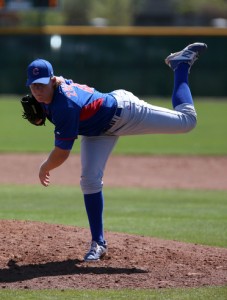
Rob Zastryzny, LHP, Cubs
Rob Zastryzny, LHP, Cubs
Ht/Wt: 6’3″/205 | B/T: R/L | Age (as of 1/1/2016): 23y, 9m
Acquisition Period: 2nd Rd., 2013 MLB First-Year Player Draft (CHI)
2015 Stats (Double-A): 2-5 W/L | 6.23 ERA | 60.2 IP | K/BB: 48/28
What he brings: Zastryzny is a versatile lefty with a solid-average fastball that is generally 88-92. He’ll add and subtract from his fastball but he’s not strictly a finesse pitcher. He can reach back and hit 94 at times and has shown the ability to miss bats (25.5% K rate in the AFL). His best overall offering is a changeup, an above-average pitch has potential to be useful even against off-hand hitters, and adds to his ability to keep hitters off balance. He has changed the grip on his curve and while it has improved, it is sill a work in progress as far as consistency. It has shown flashes of being an average offering, but if he can at least develop it to the point where it is fringe-average, he can employ it as a chase pitch he can use ahead in the count.
Why he’s a likely role player: Zastryzny has generally shown good control but the command can waver, and his stuff isn’t good enough to get away with mistakes up in the zone, so limiting his exposure may put him in a better position to succeed. The lack of a consistent third pitch also tempers his potential as a full-time starter right now. If the curve becomes an average pitch, then Zastryzny could become a bottom of the rotation starter.
How he fits: I envision Zastryzny filling a Travis Wood-type role where he can be used out of the bullpen and put in the occasional spot start. As a reliever, Zastryzny may be able to sit more in the 91-94 range we’ve seen at times, and his changeup will help project him as more than just a LOOGY. As a starter, he’ll have to mix and match his pitches more, but he should be successful if he is used as a change-of-pace starter in the right matchups. Wood is already getting expensive, and he’ll be a free agent at the end of the season, which should give Zastryzny enough time to serve as minor league depth – honing his craft at Triple-A Iowa in 2016.
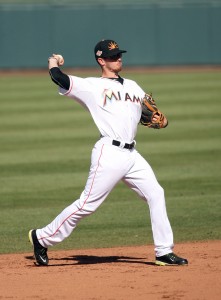
J.T. Riddle, IF, Marlins
J.T. Riddle, IF, Marlins
Ht/Wt: 6’3″/180 | B/T: L/R | Age (as of 1/1/15): 24y, 3m
Acquisition Period: 13th Rd., 2013 MLB First-Year Player Draft (MIA)
2015 Stats (Double-A only): 189 PA | .289/.323/.422 | 5 HR | 20 RBI
What he brings: Riddle has the tools to play a solid-average shortstop on an everyday basis. That by itself gives him value on a major league roster. Unlike the other hitters on this list, Riddle has a swing path that gives him some HR potential, though it has yet to manifest itself in games to this point. He’s an average athlete with the above-average arm to play short and third, as well as second base.
Why he’s a likely role player: Riddle is an aggressive hitter with an average ceiling on his hit tool. That doesn’t bode well for his ability to get on base consistently and if the power doesn’t come, then he is not going to provide enough offense to carry a starting role — and certainly not enough to displace the defensively superior Adeiny Hechevarria.
How he fits: Hechavarria is cost-controlled for three more seasons and Dee Gordon has been signed to a long-term deal, so the middle infield positions are likely blocked with the big club for the next few years. Riddle could return to Double-A Jacksonville or start at Triple-A New Orleans, so he may be ready as soon as 2017, where he might have an opportunity to start at third base. Martin Prado will become a free agent after the 2016 season, and Riddle’s major competition from within the Marlins system will come from Brian Anderson, who has more present power. Riddle will have to show he can hit for some power and get on base enough to be a viable option at third. If not, he fits best as a utility infielder at all infield positions, who should provide solid defense and perhaps a little pop off the bench.
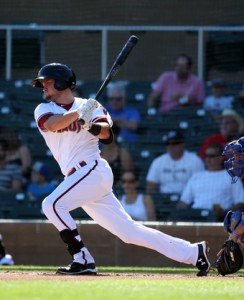
Jack Reinheimer, IF, Diamondbacks
Jack Reinheimer, IF, Diamondbacks
Ht/Wt: 6’1″/186 | B/T: R/R | Age (as of 1/1/2016): 23y, 6m
Acquisition Period: 5th Rd., 2013 MLB First-Year Player Draft (SEA)
2015 Stats (Double-A JAX/MOB): 547 PA | .270/.342/.363 | 5 HR | 42 RBI
What he brings: Reinheimer is the best defensive player on this list. He moves his feet well and flows through the ball – what you like to see from middle infielders. His hands are soft and he’ll consistently make the plays he is supposed to make. At the plate he makes consistent contact and shows a disciplined approach, which has helped him draw a fair amount of walks. He’s also an above average baserunner who can steal the occasional base.
Why he’s a likely role player: While he has the range, hands, and instincts, Reinheimer may not have the arm strength to be a full-time shortstop and has well below-average power, so he will very likely not have enough bat for the other infield positions. His best hope as a starter is as a defense-first shortstop, but that role is currently held by Nick Ahmed.
How he fits: Reinheimer’s best fit is as a prototypical defense-oriented utility infielder. The Diamondbacks, however, don’t seem quite settled in their middle infield. Chris Owings hasn’t yet lived up to expectations and the competitive Diamondbacks may be contemplating a veteran stopgap at second base for 2016 (such as free agent second baseman Howie Kendrick), according to Bob Nightingale (Ed. Note. – Kendrick signed with the Dodgers on January 29) That seems to indicate the second base job could be up for grabs down the road, but the long term offers some competition as well. The Diamondbacks have Brandon Drury ahead of him on the organizational ladder with Domingo Leybar right behind him. At the very least, the polished Reinheimer should provide solid depth and strong defense at all infield positions.
These role-type players may not get the average fan excited, but major league teams absolutely see the value in them. The game is filled with such players — from everyday utility infielders or bullpen arms, to versatile, jack-of-all-trades roster savers like the Red Sox 2015 seven position All-Star Brock Holt, to staff-saving swingmen like the Cubs left-hander Travis Wood, to currency preserving stopgaps like Cardinal Tommy Pham, and on to once lightly regarded prospects like Giants third baseman Matt Duffy, who unexpectedly made the jump to impact starters. They may not carry the hype, upside, or star potential that top prospects do, but Role 4 players certainly have their place in the game.

